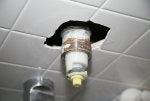Hi.
I am new to this forum.
I need help fixing leak to Delta Monitor 1400 series shower/tub faucet. After speaking to Delta's customer service, they will be sending me a new valve stem cartridge.
This is my first time replacing the cartridge. Pardon me if my terminology is incorrect.
I am attaching some photos. Is the brass bonnet nut the greenish ring around the cartridge? If so, it seems impossible to remove. Delta's customer service told me to use some hot white vinegar to take some of the calcification off. I tried doing so for awhile but was not able to even make the part budge.
I've attached two photos with red arrows. Are the arrows pointing to the brass bonnet nut?
Any ideas on how to remove the bonnet?
Thank you very much. Any help is greatly appreciated.
Mike
I am new to this forum.
I need help fixing leak to Delta Monitor 1400 series shower/tub faucet. After speaking to Delta's customer service, they will be sending me a new valve stem cartridge.
This is my first time replacing the cartridge. Pardon me if my terminology is incorrect.
I am attaching some photos. Is the brass bonnet nut the greenish ring around the cartridge? If so, it seems impossible to remove. Delta's customer service told me to use some hot white vinegar to take some of the calcification off. I tried doing so for awhile but was not able to even make the part budge.
I've attached two photos with red arrows. Are the arrows pointing to the brass bonnet nut?
Any ideas on how to remove the bonnet?
Thank you very much. Any help is greatly appreciated.
Mike







